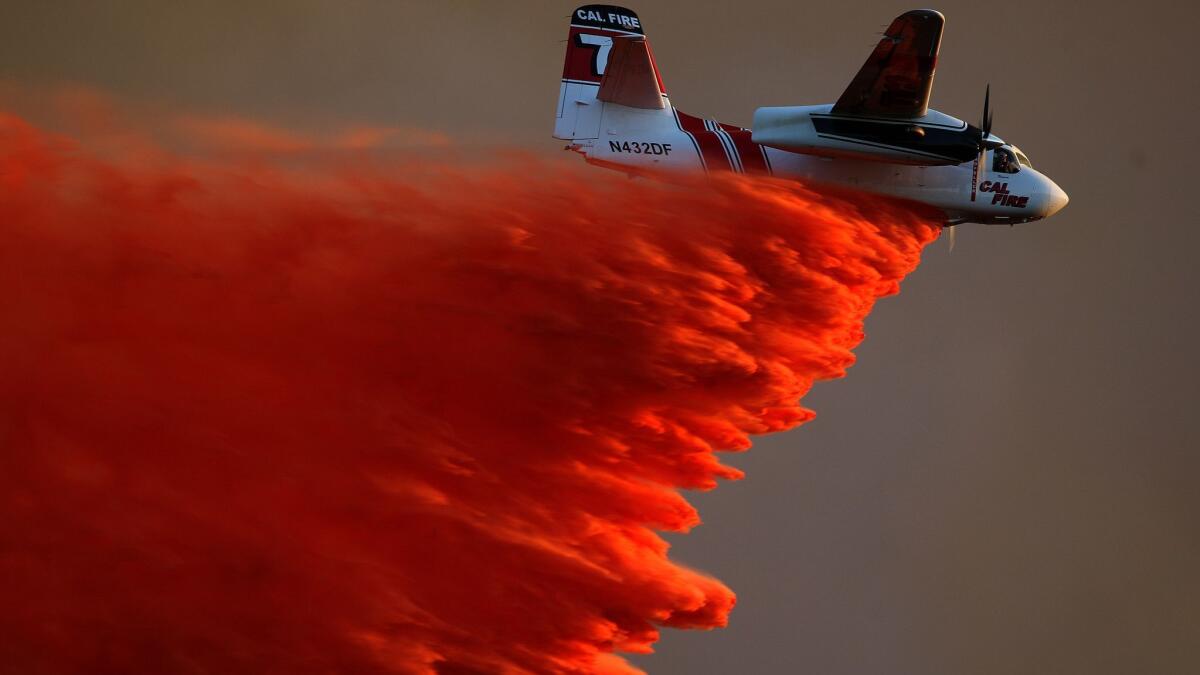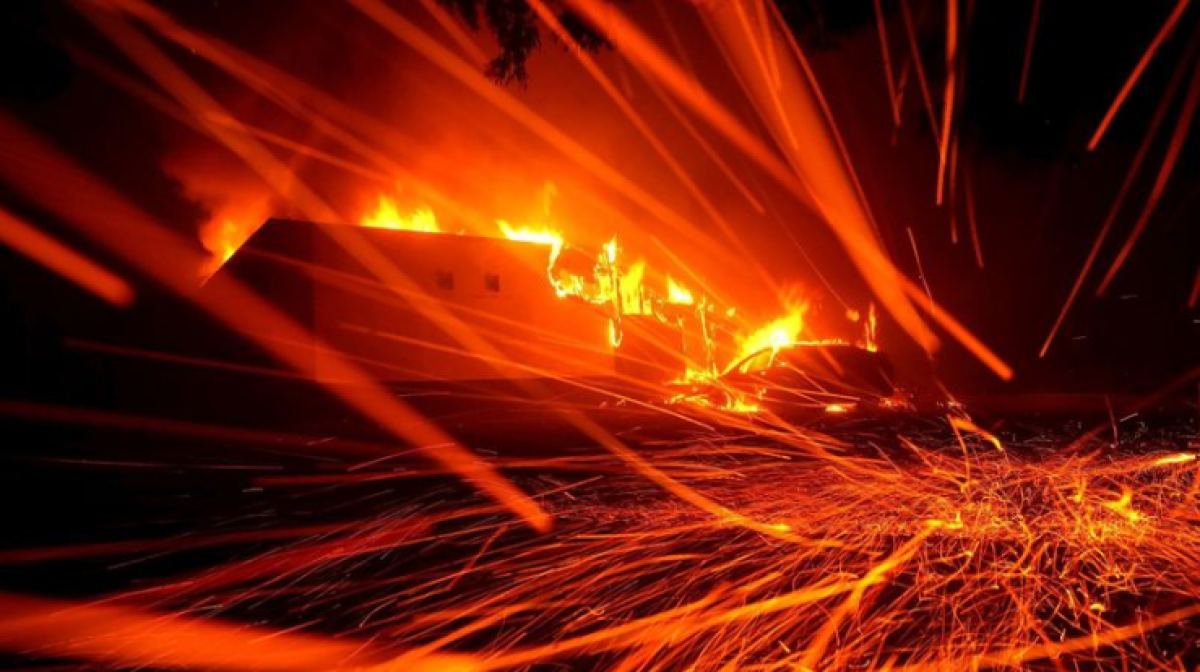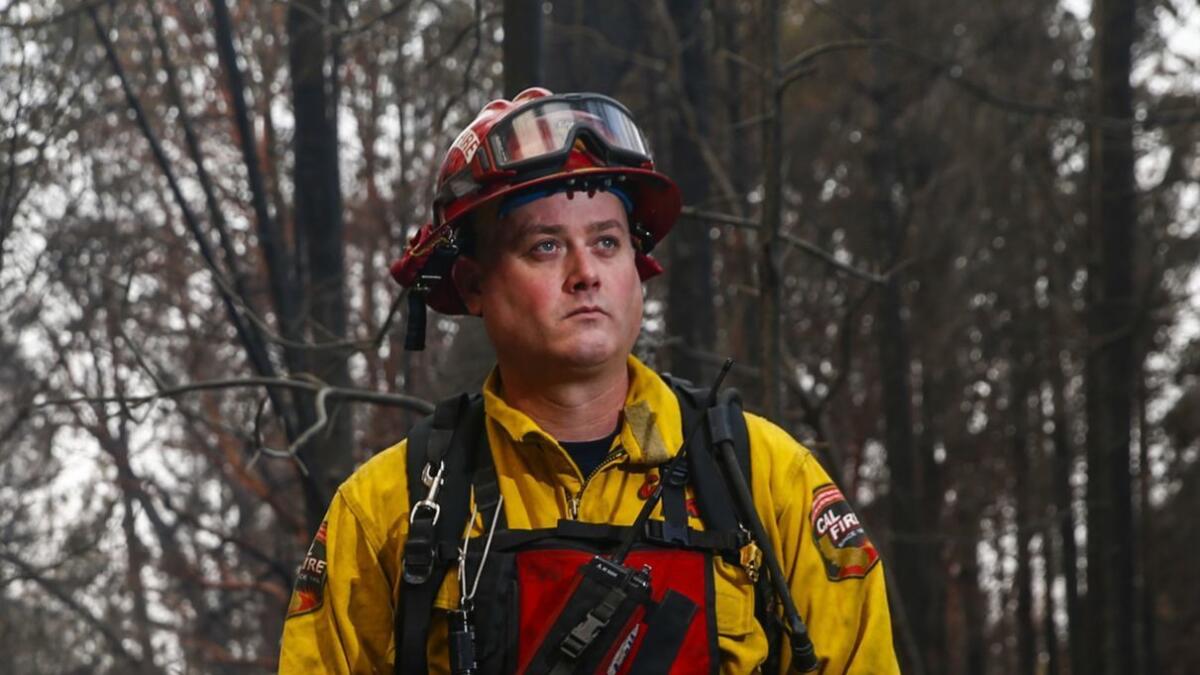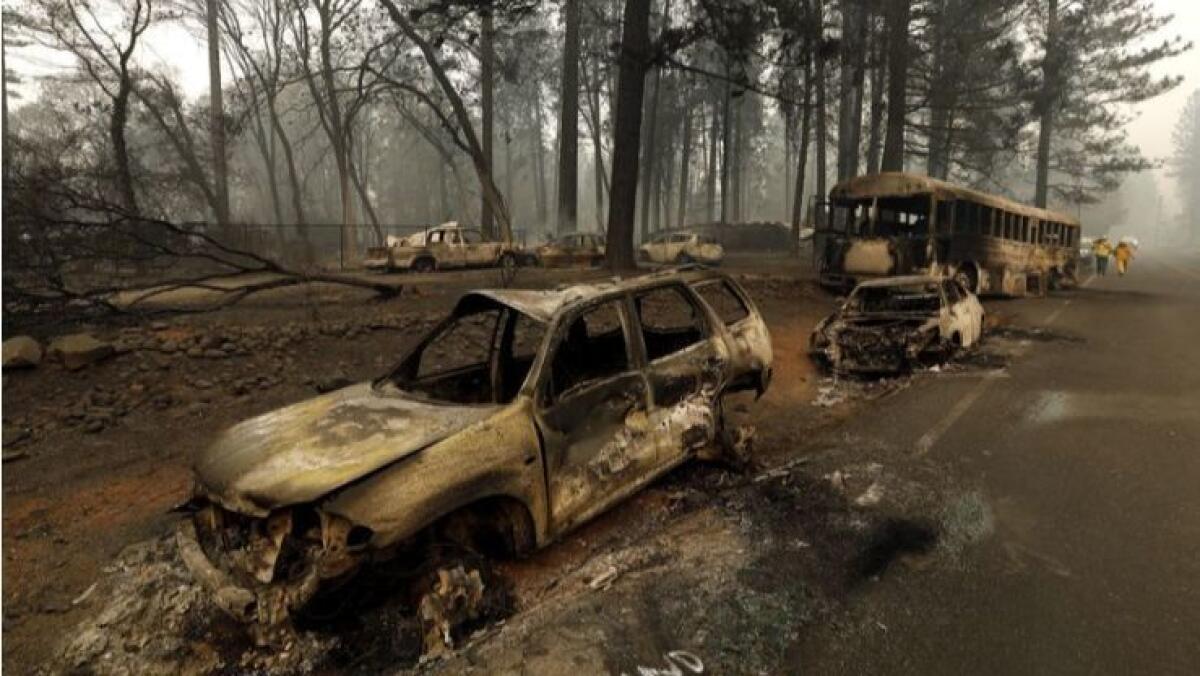Firefighting aircraft ‘increasingly ineffective’ amid worsening wildfires

- Share via
The flames erupted just after sunrise on a high canyon wall, far beyond the reach of earthbound firefighters.
For the record:
12:45 p.m. April 8, 2019This story refers to the OV-10 Bronco aircraft as “larger” than an S2-T tanker. The OV-10 Bronco has a smaller gross weight than the S2-T.
As powerful winds sent embers rocketing through the Sierra Nevada foothills, and closer to the towns of Magalia, Concow and Paradise, fire crews radioed anxiously for aircraft.
“Any news on air attack?” demanded one commander. “Let’s get stuff up that we can get up.”
But it would take nearly two hours for the first water-dropping helicopter to arrive, and roughly six hours for the first air tankers to drop retardant on the fire, because of dangerously strong winds.
Now, in the aftermath of the Camp fire, which killed 85 people and caused up to $13 billion in damage, some are calling Cal Fire’s use of air tankers “costly and increasingly ineffective.”
They insist that fixed-wing air tankers are too vulnerable to the blinding smoke and high winds of extreme fire conditions.

For residents living in wildfire country, the sight of airplanes spewing clouds of pink retardant and helicopters dumping torrents of water onto flames can bring hope and reassurance — regardless of their usefulness in fighting a fire. Similarly, the absence of aircraft from a wildfire will quickly inspire public criticism and outrage.
But the unprecedented death and destruction that wildfires have brought to California the last two years have demonstrated the sharp limitations aircraft have when battling extreme fire behavior.
“There’s ‘why weren’t air tankers flying? Why don’t you have 747s?’ Like the aircraft are some kind of panacea,” said Dennis Brown, aviation chief with the California Department of Forestry and Fire Protection. “Sometimes they’re not necessary and sometimes they’re not practical. It’s a risk versus gain.”
Officials say the department’s aerial fleet can use retardant to slow the movement of a flame front, or use water drops to douse spot fires and clear escape routes. However, they say firefighting aircraft are no match for the types of wind-driven fire storms that have killed more than 130 people and taken out 20,000 homes since October 2017.
The shortcomings of aircraft battling a massive wind-driven wildfire were painfully apparent in the early hours of the Camp fire.
Although the official cause of the fire remains under investigation, the blaze began near a Pacific Gas & Electric transmission tower, and the utility has announced that it was “probable that its equipment will be determined to be an ignition point of the fire.”
The fire began at 6:29 a.m. Nov. 8 on a high point in a canyon near the foothill town of Pulga. The flames, fanned by strong seasonal winds, spread quickly through dry grass and timber, officials say. Across the canyon floor, Cal Fire firefighter Matt McKenzie said he was helpless to stop the wildfire. The nearest access road was too steep for his department’s equipment, and the fire was likely to outrun any ground crews that could navigate the terrain on foot.
At 6:45 a.m., McKenzie put in a request with Cal Fire to get its fleet of helicopters and air tankers up earlier than scheduled. Cal Fire had told pilots to be ready to fly at 8 a.m., because of red flag conditions.

Pilot Dave Kelly had heard radio reports of the fire and decided to leave for work early. He was alone in his S2-T tanker when he took off at 7:44 a.m. that Thursday morning. A larger OV-10 Bronco air attack plane that orbits at a higher elevation, so as to supervise and coordinate other firefighting aircraft, was two minutes behind him.
Kelly was the first pilot to fly over the Camp fire as smoke blotted out the sun and wind gusts carried burning chunks of vegetation and debris into the nearby towns of Paradise, Magalia and Concow, sparking new fires.
“It was just … getting the crap beat out of you, basically,” Kelly said of flying amid heavy wind gusts.
He first flew northeast to the origin point of the fire — at the mouth of a Feather River canyon where he estimated winds were blasting at nearly 60 mph — and knew any retardant drop to cut off its flank was pointless.
“It’d probably still be in the air,” said Kelly, who has been piloting tankers since the fire storms in Southern California in 2003.
He banked his airplane to the right and made a loop. He then headed to the fire’s western edge but found it was too turbulent to drop retardant. He then banked left and made a full loop until he was headed east, toward the fire’s other flank.
Down in front of him, barely visible in the smoke, lay rows of unburned homes where he could drop pink retardant, its chemical mixture making anything it coats tougher to burn.
When tankers drop retardant, their goal is to be as slow and low as possible, Kelly said. To do that, pilots will pull their plane’s flaps all the way down — creating more surface area along the wings to increase air resistance and giving the pilot greater control — while at the same time rolling back on the throttle to slow the tanker to a relative crawl as it sinks in the air closer to the target.
So Kelly put the flaps all the way down, lowered the throttle and attempted his approach toward Paradise.
But instead of descending toward his target, his plane climbed 1,000 feet.
The winds that rolled over the Sierra Nevada ridges and up the canyon walls were lifting Kelly’s 30,000-pound tanker when it should’ve dropped like a stone. Jostled continuously in the air, Kelly was forced to abandon the mission. Had he tried to approach it in the opposite direction, the winds rolling over the hills could’ve shoved his plane down to the ground without giving him time to react.
Kelly returned to the air base at 8:29 a.m., without dropping any retardant on the fire. The air attack supervisor orbiting above announced that all fixed-wing aircraft were grounded until further notice because of the conditions. Only helicopters, which can function in higher winds, managed to operate during the fire and dropped water on evacuation routes to help residents escape.
“The hardest part is not being able to do your job,” Kelly said. “Just sitting on the ground, everybody on the radios calling out. I kept hearing people sheltering in place and knowing people are going through that kind of traumatic event and you’re just sitting there, helpless.”
Fires like the one that destroyed Paradise in November and Santa Rosa in 2017 don’t stop growing until the wind dies down, said Frank Carroll, a retired 31-year firefighting veteran with the U.S. Forest Service.
“There’s no combination of firefighters on the planet that could’ve altered the outcome,” Carroll said.
But crews on the ground in Paradise may not have realized that at the time. Firefighters were heard in dispatch recordings repeatedly asking about air support in the fire’s first hours.
“It’s often symbolic. That’s not a damning thing, that’s a fact. You can’t watch 19,000 structures burn. You have to throw everything at it you can find,” Carroll said. “You got to take your engine, your aircraft, knowing all the time it’s not going to have any effect.”
Some residents who were slow to evacuate said they didn’t realize how bad it was, in part, due to the absence of air tankers roaring over their neighborhoods.
“As much as we want to get the red stuff on the ground where we need it, the effectiveness becomes pretty limited in the wind,” said Jeffrey Kline, a former fire management officer with the Bureau of Land Management.
Cal Fire has long identified itself as having the world’s premier firefighting aviation program, and is now poised to spend $288 million on a dozen new twin-engine Sikorsky Black Hawk helicopters and seven C-130H air tankers, some of which will arrive this summer.
After the Camp fire, however, critics are questioning that expense.
“While the Camp fire raged through Paradise, a fleet of air tankers located literally next door in Chico was grounded by high winds and dense smoke,” wrote Timothy Ingalsbee, executive director of Firefighters United for Safety, Ethics and Ecology.
In a report that harshly criticized the state’s wildfire suppression strategy, Ingalsbee and other experts urged Gov. Gavin Newsom to convene a special task force on protecting homes from wildfire and warned that plans to expand Cal Fire’s fleet of air tankers “would be a poor investment of taxpayer dollars.”
The report, published by the Leonardo DiCaprio Foundation, said the state instead needs to focus its energy and funding on preparing communities to live in fire-prone environments. Among other criticisms, it says the department has undermined its ability to combat fires by refusing to schedule aircraft during early morning hours — when studies suggest water and retardant drops are most effective — and focusing instead on the hottest period of the day.

Because Cal Fire pilots are scheduled to begin flying no earlier than 10 a.m., or in certain cases 8 a.m., and are also barred from flying in darkness, there are many fires they are unable to reach during the critical early moments. Of the state’s 10 most destructive wildfires, half were ignited in darkness, or more than an hour before pilots were scheduled to begin operations, according to state fire data.
The reason for starting most pilot shifts at 10 a.m. is a compromise between pilot safety and firefighting capability, officials say. Cal Fire pilots and those they contract with are limited to flying no more than seven hours a day solo, or eight hours with a co-pilot as part of a 14-hour shift. By starting at 10 a.m., pilots are able to battle fires in the morning, as well as the early afternoon, when the day is warmest and wildfires burn most intensely.
“It’s a gamble either way that you go…We found that having more assets available in the peak burning period is a benefit,” Brown said. “It’s really uncommon for [fires] to start early and go large.”
It would take two or three times the number of pilots available — and enough aircraft capable of flying at all hours — to have that kind of aggressive response around the clock, Brown said. It would also be incredibly expensive. The Cal Fire aviation budget for the 2017-2018 fiscal year was $55.6 million — roughly 3% of Cal Fire’s overall budget of $2.1 billion.
Cal Fire staggers pilot schedules only after a big fire has established itself so pilots can attack it from the air for longer periods of the day, but generally not before then, Brown said.
Critics say this is a mistake.
Studies show that retardant is most effective in slowing fire growth in sparse vegetation on flat land in cool conditions, not so much at the peak of the afternoon under the blazing sun. Though firefighters can’t control where a fire erupts, if it happens in the morning (and wind conditions permit,) they’d have a better chance of slowing the fire’s growth with retardant than they would if it broke out in the afternoon, Ingalsbee said.
A Los Angeles Times analysis of Cal Fire incident information dating to 2003 found that just over a quarter of wildfires, or 26.7%, began before or after the 10 a.m.-to-6 p.m. flying window. However, large wildfires, or wildfires over 10,000 acres, were even more likely to start outside the typical flight operations window. Just over half of those fires, or 53.3%, began before or after that same flight window.
“Those fires get large for a reason and it’s typically because of a wind event or something predictable on those days,” Brown said. “There are conditions that it doesn’t matter how early we come on, some fires are going to get large.”
More to Read
Sign up for Essential California
The most important California stories and recommendations in your inbox every morning.
You may occasionally receive promotional content from the Los Angeles Times.












